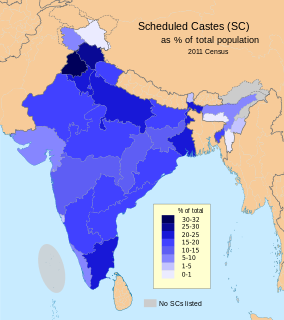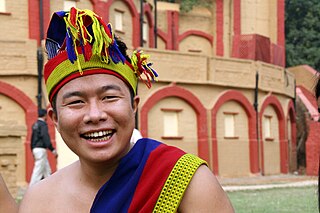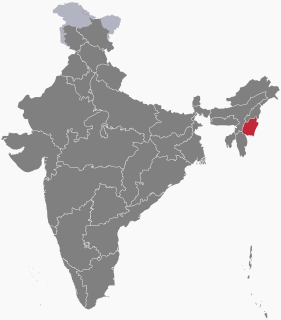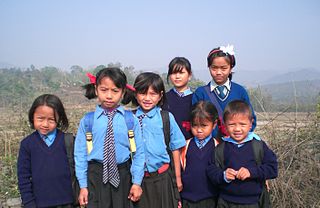Related Research Articles

Nagaland is a state in northeastern India. It is bordered by the state of Arunachal Pradesh to the north, Assam to the west, Manipur to the south and the Sagaing Region of Myanmar to the east. Its capital city is Kohima and its largest city is Dimapur. It has an area of 16,579 square kilometres (6,401 sq mi) with a population of 1,980,602 per the 2011 Census of India, making it one of India's smallest states.

The Scheduled Castes (SCs) and Scheduled Tribes (STs) are officially designated groups of people and among the most disadvantaged socio-economic groups in India. The terms are recognized in the Constitution of India and the groups are designated in one or other of the categories. For much of the period of British rule in the Indian subcontinent, they were known as the Depressed Classes.
Nagas are various ethnic groups native to northeastern India and northwestern Myanmar. The groups have similar cultures and traditions, and form the majority of population in the Indian state of Nagaland and Naga Self-Administered Zone of Myanmar; with significant populations in Manipur, and Assam in India; Sagaing Region and Kachin State in Myanmar (Burma).

Dima Hasao district, earlier called North Cachar Hills district, is an administrative district in the state of Assam, India. As of 2011, it is the least populous district of Assam.
The Angamis are a major Naga ethnic group native to the state of Nagaland in North-East India. The Angami Nagas are predominantly settled in Kohima District, Chümoukedima District and Dimapur District of Nagaland and are also recognized as one of the ethnic groups in the state of Manipur. The Angamis are divided into four regions namely Chakhro Angami, Northern Angami, Southern Angami and Western Angami. The now separated Chakhesangs were previously known as the Eastern Angamis.

The Rongmei are one of the major indigenous communities a part of the Naga tribes of North-East India. The Rongmei Naga are a scheduled tribe under the Constitution of India. The Rongmei have a rich culture, customs and traditions. They share similarity with their kindred tribes of Zeme, Liangmai and Inpui which together are known as Zeliangrong.
The Milhiems are an ethnic group living in parts of Northeast India and Myanmar. Some writers refer to them as Milhem, Meriem, Mirem, Marrem or Miriam. They belong to the "Old Kuki tribes" of Manipur. The Milhiems believe that they descend from a common ancestor who came from a cave which they call Khul. Their history is based on oral tradition, folklore and myth handed down from one generation to the next. Their society is organised into clans and subclans. The village is the highest unit of society and lands belong to the village chief, who is considered the head of their clan or subclan. Some Milhiem clans and subclans are scattered among other Old Kuki tribes such as the Chothe, Purum, Koireng, Kom, Lamkang, Aimol, Maring, Tarao, Vaiphei, Paite, Lusei and also among the Thadou-kuki tribe.

The Naga Self-Administered Zone, is a self-administered zone in the Naga Hills area of Sagaing Region of Myanmar. Its administrative seat is the town of Lahe.
The Naga Hills District was a former district of the Assam province of British India. Located in the Naga Hills, it was mainly inhabited by the Naga tribes. The area is now part of the Nagaland state.
Lamkang is a Naga language spoken by Lamkang Naga of Manipur, India, with one village in Burma. The Lamkangs are mostly settled in the southwest and southeastern parts of Manipur. The language has been influenced by the state language Meitei as the people have been in contact with Meiteis, and as Meitei is used as a lingua franca among local tribes. There are current language documentation efforts by native speakers including Bible Translation by Mr. Swamy Tholung Ksen under the Bibles International, Pautum Ren the collection of traditional stories songs Children's story book Knao Bu Then, Naoluwng Paomin, published by SIL, and the Universal Declaration Of Human Rights (UDHR) and United Nations Declaration on the Rights of Indigenous Peoples (UNDRIP) translated by Sumshot Khular, and videography of traditional dances and stories and work on creating a standard orthography.
The predominant religion of Nagaland is Christianity. The state's population is 1.988 million, out of which 90.02% are Christians. More than 98% of the Naga people identify themselves as Christian. The 2001 census recorded the state's Christian population at 1,790,350, making it, with Meghalaya and Mizoram, one of the three Christian-majority states in India and the only state where Christians form 90% of the population. The state has a very high church attendance rate in both urban and rural areas. Huge churches dominate the skylines of Kohima, Dimapur, and Mokokchung.
The Inpui tribe are one of the indigenous Naga tribes of Manipur, India. The majority of the Inpuis are settled in the Haochong subdivision in Noney District, and in Tamenglong district, Manipur. Inpuis are also settled in Makuilongdi, Senapati headquarter, & Inthan (Waphong) in Senapati district and also in Changangei, Tamphagei, Yurembam, Pantilong, Sagolband in Imphal west district in Manipur. Moreover, Inpuis are also settled in Nagaland and Assam as well. The highest peak in Inpui Naga land is Antrimon 12 km far away from Haochong village and numerous rivers and streams run through the land like Tuilang, Lingkwa and Ra-ah.

The Anāl are some of the oldest settlers of the present day Manipur. They belong to the Naga tribe native to Manipur state in North-East India and part of Myanmar. They are listed as a Scheduled Tribe, in accordance with The Scheduled Castes and Scheduled Tribes Orders (Amendment) Act, 1976 Indian Constitution. The Anāl tribe is one of the 'sixty six Naga tribes' of the Naga ancestral homeland. The members of this tribe are found both in India and Myanmar. In India, they are situated in the States of Manipur and Nagaland but mostly concentrated in the former. In the State of Manipur, the Anāl Naga population concentrated in Chandel and a few Anāl villages are located in its neighbouring districts, Churachandpur district has about three villages and Thoubal district has one or two.

The following outline is provided as an overview of and topical guide to Manipur:

Kamjong District is a district in Manipur state, India created by splitting Ukhrul district.
The Moyon Naga also known as Bujuur, are one of the Naga ethnic group that mostly resides in Manipur, India and some in Sagaing Region, Myanmar. They are listed as a Scheduled Tribe, in accordance with The Scheduled Castes and Scheduled Tribes Orders (Amendment) Act, 1976 Indian Constitution. They share close cultural and linguistic affinity with Monsang Naga tribe.

The hill tribes of Northeast India are hill people, mostly classified as Scheduled Tribes (STs), who live in the Northeast India region. This region has the largest proportion of scheduled tribes in the country.
The Chiru tribe is one of the Naga tribes that mostly resides in Manipur and some in Assam, India. They are listed as a Scheduled Tribe, in accordance with The Scheduled Castes and Scheduled Tribes Orders (Amendment) Act, 1976 Indian Constitution.
The Chirr tribe is one of the Naga tribes that mostly resides in Nagaland, India. They are listed as a Scheduled Tribe, in the official Census of India. However, due to lack of official recognition from Government of Nagaland are considered sub-tribe of Yimkhiung Nagas.
References
- ↑ "Census of India 2011". MHA, Govt of India.
- ↑ "Brief Account of the Lamkang Naga".
- ↑ "1THE CONSTITUTION (SCHEDULED TRIBES)". Archived from the original on 2017-09-20. Retrieved 2016-07-31.
